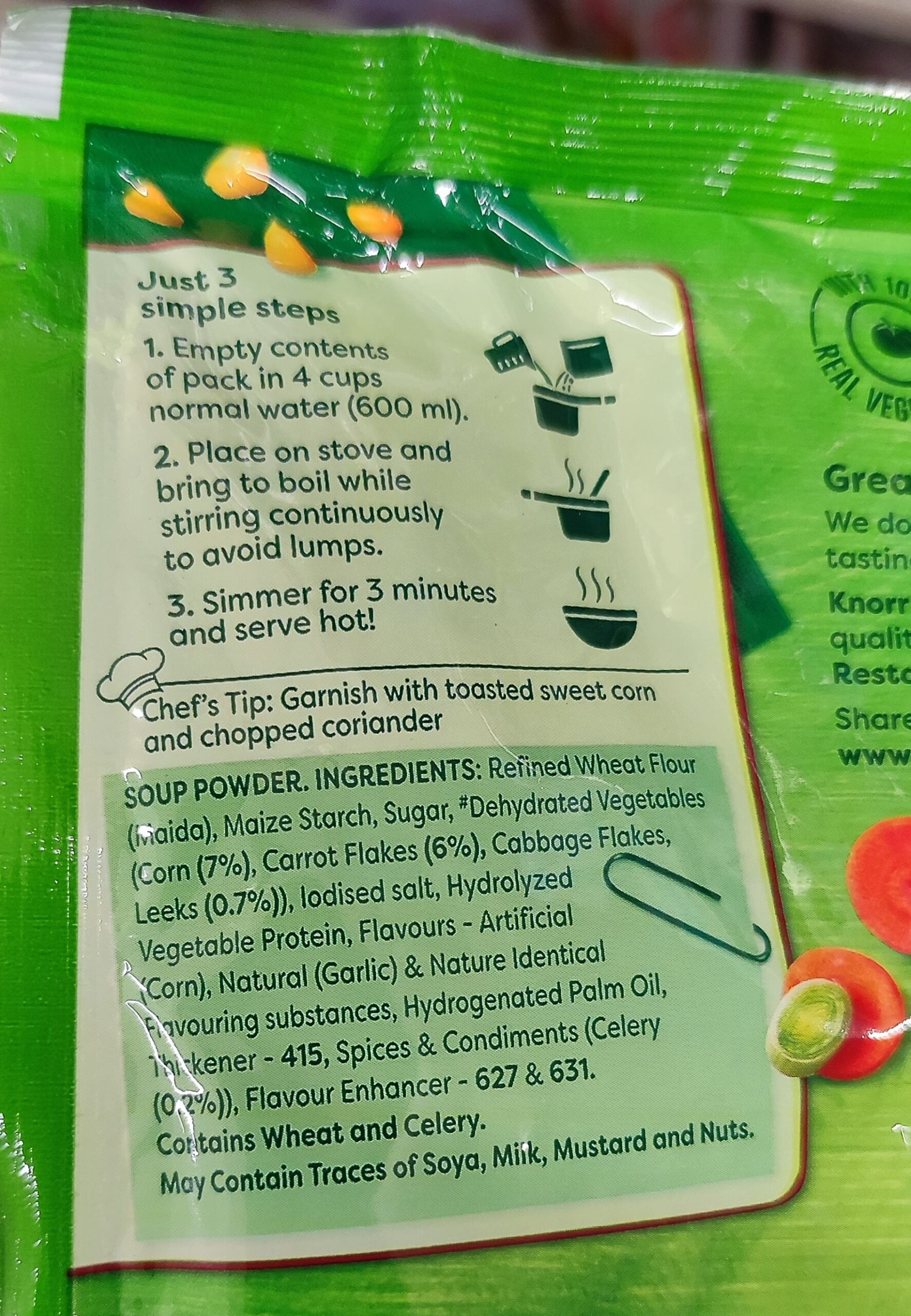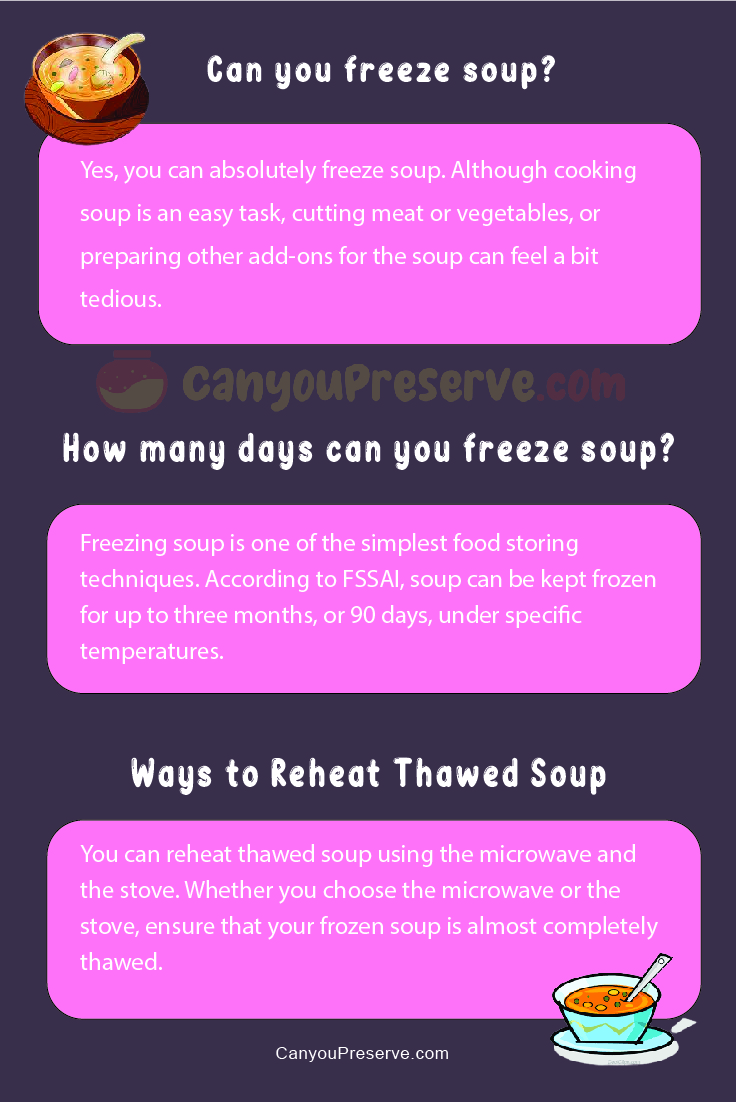Can you freeze soup?: Soup is one of the easiest food items to prepare and store. It takes only a few minutes to cook a nutritional bowl of soup, and you get the advantage of being able to store it for many days. People generally freeze soup either for self-consumption or for safe selling.
So, if you are thinking about cooking a large volume of soup to last you for more than a week, then the best way to store this is by freezing it. This article covers everything that you would want to know. It includes information on whether can you freeze soup, if yes then the process of freezing and thawing soup and storing concerns.
- Can you freeze soup?
- How to freeze soup?
- How many days can you freeze soup?
- Can you freeze soup in Tupperware?
- Can you freeze soup with cream in it?
- Can you freeze soup with meat?
- How To Defrost Frozen Soup?
- Ways to Reheat Thawed Soup
- FAQs on How To Preserve Soup in the Freezer?

Can you freeze soup?
Yes, you can absolutely freeze soup. Although cooking soup is an easy task, cutting meat or vegetables, or preparing other add-ons for the soup can feel a bit tedious. This is why cooking soup every day will just be troublesome for people who may find it difficult to make time. No wonder, freezing soup is such a popular solution to this worry nowadays. Thankfully, freezing soup as a means of safe storing has almost no effect on its taste or its nutritional value.
How to freeze soup?
When you are cooking soup, you are probably making it in a big pot. But when it comes to storing it by freezing, putting the big pot in the freezer is definitely not the answer. The best solution to this is to store soup in smaller containers.
Divide the soup into individual or family-sized servings in a freezer-friendly container for equal freezing and heating. If you store everything in a single big pot, then, the centre will be susceptible to lumpy freezing. You can use any type of container that can be closed with a lid, and which will not crack under extremely low temperatures.
Choosing to store soup in the freezer in several containers will make it easier for you to thaw and heat it. You might not want to put the leftover reheated soup back into the freezer to be frozen which is why using smaller containers makes perfect sense.
Always remember to not fill soup right up to the brim of the container because soup will expand when frozen. Thus, it is better to leave a bit of space between the lid and the soup. You should put soup in the freezer the same day that you have prepared it to eliminate any chance of food poisoning.
How many days can you freeze soup?
Freezing soup is one of the simplest food storing techniques. According to FSSAI, soup can be kept frozen for up to three months, or 90 days, under specific temperatures. If the soup was properly cooked, stored in good containers, and defrosted using the right techniques, then three months is the standard storage period for soup.
But, of course, you should store soup in the freezer in its frozen state only under exceptional circumstances and not make it a regular habit. This is because you do not want your soup to start tasting stale.
Each time you freeze and unfreeze your soup, you will notice a change in taste. But this does not entirely indicate that it has gone bad. Any food that stays frozen for months develops ice crystals in the food’s fibers that change the food’s taste and texture a bit.



Just 3 Simple Steps
- Empty the contents of the pack in 4 cups of normal water (600 ml).
- Place on stove and bring to boil while stirring continuously to avoid lumps.
- Simmer for 3 minutes and serve hot!
Chef’s Tip: Garnish with toasted sweet corn and chopped coriander
Soup Powder Ingredients:
Refined Wheat Flour (maida), Maize Starch, Sugar, #Dehydrated Vegetables (Corn (7%), Carrot Flakes (6%), Cabbage Flakes, Leeks (0.7%)), Iodised Salt, Hydrolyzed Vegetable Protein, Flavours – Artificial (Corn), Natural (Garlic) & Nature Identical Favouring Substances, Hydrogenated Palm Oil, Thickener – 415, Spices & Condiments (Celery (0.2%)), Flavour Enhancer – 627 & 631.
Contains Wheat and Celery.
May Contain Traces of Soya, milk, Mustard, and Nuts.
Nutrition Information (Typical Values)
This pack serves 4
Per Serve: 160.5 g (10.5 g Soup Powder + 150 ml Water)
| Nutrients | Per 100 g Product | Per Serve | %RDA^/Serve |
| Energy (kcal) | 326 | 34 | 2% |
| Protein (g) | 7.2 | 0.8 | – |
| Carbohydrate (g) | 70.6 | 7.4 | – |
| Total Sugars (g) | 23.9 | 2.5 | – |
| Added Sugars (g) | 16.8 | 1.8 | 4% |
| Dietary Fibre (g) | 4.4 | 0.5 | – |
| Total Fat (g) | 2.6 | 0.3 | <1% |
| Saturated Fat (g) | 1.2 | 0.1 | <1% |
| Trans Fat (g) | 0.02 | Trace | <1% |
| Cholesterol (mg) | 0.1 | Trace | – |
| Sodium (mg) | 4867 | 511 | 26% |
Can you freeze soup in Tupperware?
Yes, because most Tupperware items are freezer-friendly, you can store frozen soup in Tupperware. Because most plastic material containers crack under low temperatures, freezer-friendly Tupperware containers have a little snowflake icon on top of them, indicating that you can store this container in the freezer.
Just ensure that you put the Tupperware soup in the freezer the same that you made it. You can break the soup quantity down into small Tupperware containers with enough space between the soup and lid because then it ensures easy freezing and reheating.
Can you freeze soup with cream in it?
Yes, you can freeze soup with cream in it. You only need to be careful in its thawing process as if creamy soups get reheated quickly, they might lose their thick consistency. It is better that you leave it to thaw overnight before heating it up properly.
Do Refer:
Can you freeze soup with meat?
Yes, you can easily freeze soup with meat in the freezer. There is no particular method of freezing meat soup.
How To Defrost Frozen Soup?
Defrosting frozen soup is no big deal. Depending on the time that you have on your hands, you can either let it thaw naturally or use hot water.
The usual and ideal way is to let the frozen soup container sit in the fridge, or at room temperature for a while before you heat it. But, if you are in a hurry, you can warm some water in a pot and place the soup container in it. If you want, you can even stir the soup on low flame with a bit of water once it shows signs of thawing.

Ways to Reheat Thawed Soup
You can reheat thawed soup using the microwave and the stove. Whether you choose the microwave or the stove, ensure that your frozen soup is almost completely thawed.
If you choose to heat it in the microwave, then pour the soup into a microwave-friendly container and wrap it with a plastic covering. Microwave it for two minutes, and stir it once after a minute of heating.
On the other hand, if you choose to reheat soup using the stove, then pour the thawed soup into an appropriate pot. You can add a bit of water to prevent the pot’s bottom from getting burned. Stir the thawed soup under medium flame.
FAQs on How To Preserve Soup in the Freezer?
1. Is freezing soup considered safe?
Yes, freezing soup is considered a safe practice. Even kitchen professionals follow this method for storing soup.
2. At what temperature does soup freeze?
The soup gets completely frozen at -10 F.
3. Does soup need to be cool before being frozen?
Yes, soup needs to be cool before you go on to freeze it.
4. Can you freeze soup in mason jars?
Yes, you can freeze soup in mason jars very easily. Just make sure that there is at least an inch’s space between the jar’s lid and the soup.
Key Takeaways
Hope that the information shared in this article on whether can you freeze soup has provided answers to all your doubts. These are the best possible ways to freeze soup and store it properly without tainting any safety standards. Nevertheless, if you still have questions, you can type your question in the comment section below. To know more and be updated with such basic, yet important articles, stay connected with canyoupreserve.com.








